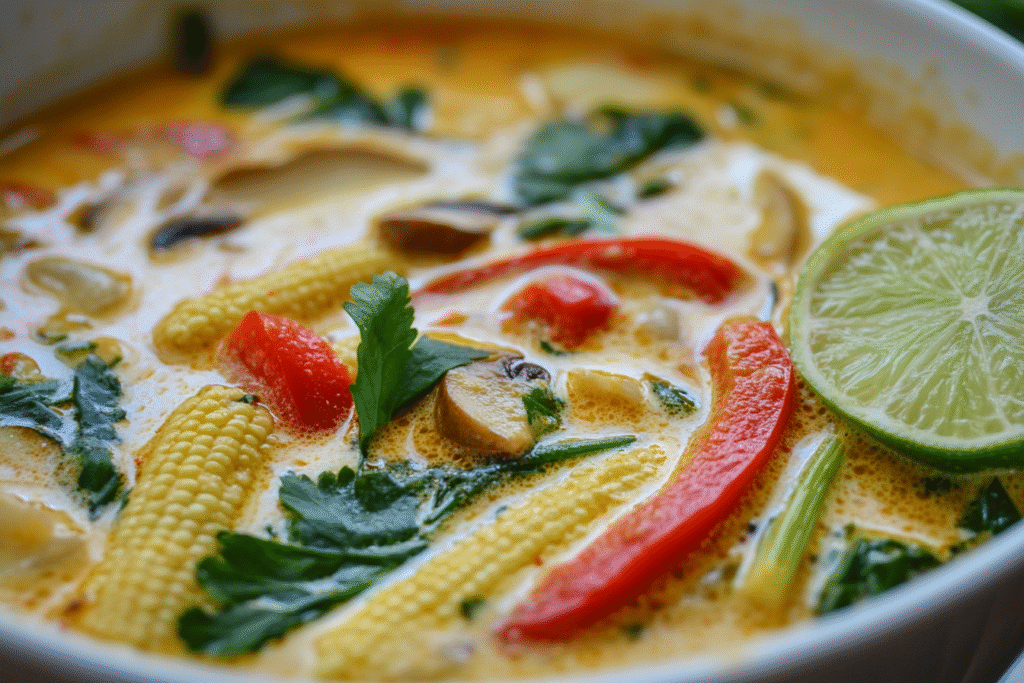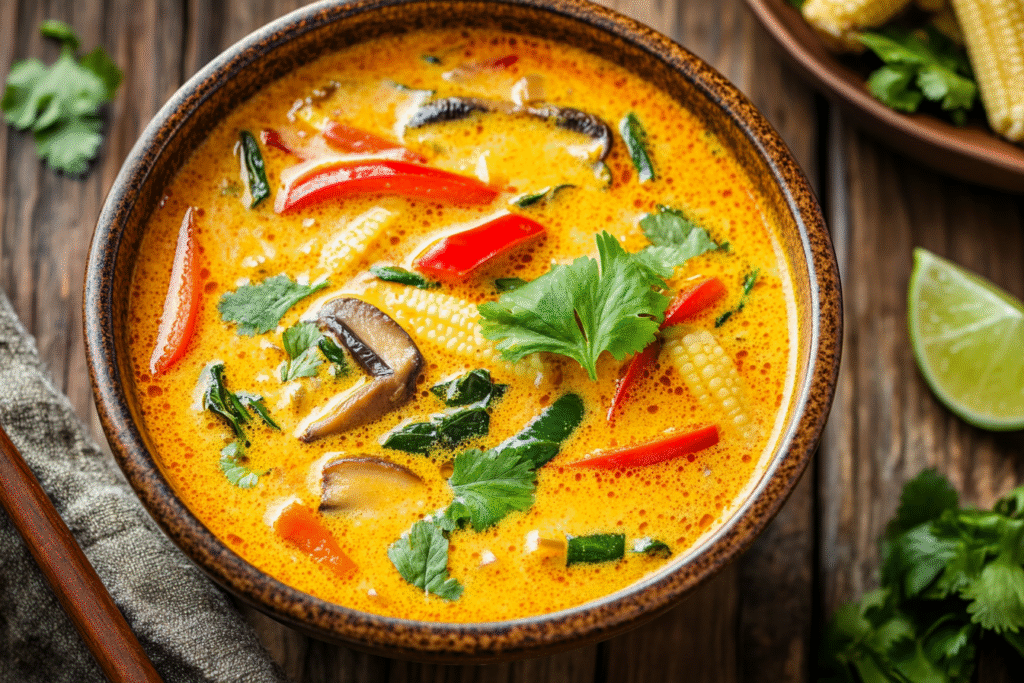Coconut Curry Soup is a fragrant, flavorful dish that combines the creamy richness of coconut milk with the bold, aromatic spices of curry. It’s a beautifully balanced soup—comforting, lightly spicy, and layered with sweetness, acidity, and a delicate warmth from ginger and garlic. This soup is incredibly versatile, perfect on its own or loaded with your favorite proteins and vegetables for a complete meal.
Whether you’re looking for something quick, cozy, and nourishing on a weeknight or aiming to impress with an elegant, globally-inspired dish, coconut curry soup is a winner. It’s one of those recipes that feels both exciting and deeply comforting, a bowl that warms you from the inside out.
Why You’ll Love Coconut Curry Soup
Coconut curry soup is the kind of dish that’s bursting with flavor but incredibly easy to make. It’s a one-pot meal that can be as simple or as complex as you want it to be.
Here’s why this soup belongs in your regular rotation:
- Creamy, mildly spicy, and perfectly balanced.
- Easily adaptable—swap vegetables, adjust the spice, or add proteins like shrimp, tofu, or chicken.
- Comes together quickly, often in under 30 minutes.
- Naturally dairy-free and can be made vegan or gluten-free with simple swaps.
- Great for meal prep and even better the next day as the flavors develop.
This soup satisfies on every level: texture, aroma, heat, and creaminess, all balanced by the brightness of lime and fresh herbs.

Choosing the Best Ingredients for Coconut Curry Soup
This soup is all about building layers of flavor with quality, fresh ingredients.
Coconut Milk
- Full-fat coconut milk delivers the best creamy texture and rich mouthfeel.
- Avoid “lite” coconut milk, which can make the soup watery and lacking in body.
Curry Paste
- Thai red curry paste is the most common and provides a balanced heat with aromatic undertones.
- You can substitute yellow curry paste for a milder flavor or green curry paste for more intense heat and brightness.
Aromatics
- Fresh garlic and ginger are essential for depth and warmth.
- Onion or shallot builds a sweet, savory base.
Vegetables
- Great options include:
- Bell peppers
- Mushrooms
- Baby corn
- Snow peas
- Carrots
- Spinach or bok choy
- The vegetables can be mixed and matched based on your preferences or what’s in season.
Broth
- Vegetable broth or chicken broth creates the soup base. Choose low-sodium to control seasoning.
Lime Juice
- Essential for balancing the richness of the coconut milk and bringing acidity to lift the flavors.
Fresh Herbs
- Cilantro, Thai basil, and green onions are excellent fresh toppings to brighten the dish.
Recommended Equipment for This Recipe
- Large stockpot or Dutch oven: Perfect for building the soup and simmering evenly.
- Microplane or grater: For fresh ginger and garlic.
- Ladle: For serving.

Common Pitfalls and How to Avoid Them
1. Soup too oily:
This can happen if the curry paste isn’t fully cooked into the coconut milk. Simmer the paste with aromatics before adding liquid to help it blend properly.
2. Soup too spicy:
Start with less curry paste and build up gradually. Coconut milk mellows spice, but you can always add more paste later if needed.
3. Soup too bland:
Don’t skip the lime juice or fresh herbs—these final layers of acidity and brightness are essential to balance the rich broth.
4. Vegetables overcooked:
Add quick-cooking vegetables like spinach or snow peas in the last minute to keep them vibrant and tender-crisp.
Flavor Enhancements and Creative Variations
- Add noodles: Rice noodles or soba noodles can make this a more substantial meal.
- Incorporate tofu, shrimp, or chicken: For added protein.
- Use lemongrass or kaffir lime leaves: For extra Thai-inspired depth.
- Finish with a drizzle of chili oil: For a spicy, fragrant kick.
- Top with roasted peanuts: Adds crunch and nutty flavor.
Smart Preparation Strategies
- Make ahead: The soup base can be made 1-2 days in advance. Add fresh herbs and delicate greens just before serving.
- Batch cooking: Easily doubled and perfect for freezing.
- Prep vegetables in advance: Chop and portion your vegetables ahead of time for a faster weeknight dinner.
Substitution Guide for Dietary Needs
- Vegan: Use vegetable broth and plant-based proteins like tofu.
- Gluten-free: Naturally gluten-free if using gluten-free broth and curry paste (check labels).
- Low-carb: Skip noodles and focus on low-carb vegetables like mushrooms, spinach, and bok choy.
Ingredients
For the Soup
- 1 tablespoon coconut oil or neutral oil
- 1 medium yellow onion, diced
- 3 garlic cloves, minced
- 1 tablespoon fresh ginger, grated
- 2 tablespoons Thai red curry paste (adjust to taste)
- 4 cups vegetable or chicken broth
- 1 can (13.5 oz) full-fat coconut milk
- 1 red bell pepper, thinly sliced
- 1 cup mushrooms, sliced
- 1 cup baby corn or snow peas
- 3 cups baby spinach or bok choy
- 1 tablespoon soy sauce or tamari (optional)
- Juice of 1 lime
- Salt and pepper to taste
Optional Garnishes
- Fresh cilantro
- Thai basil
- Green onions
- Lime wedges
- Chili oil or sriracha
- Roasted peanuts
Instructions
Step 1: Sauté the Aromatics
Heat coconut oil in a large stockpot over medium heat. Add the diced onion and cook for 4-5 minutes until softened. Stir in the garlic and ginger and cook for another 30 seconds until fragrant.
Step 2: Toast the Curry Paste
Add the Thai red curry paste to the pot and cook for 1-2 minutes, stirring frequently, to develop its flavor.
Step 3: Build the Broth
Pour in the vegetable or chicken broth and stir well to combine. Bring to a gentle simmer.
Step 4: Add Coconut Milk and Vegetables
Stir in the coconut milk, bell pepper, mushrooms, and baby corn or snow peas. Simmer for 5-7 minutes until the vegetables are tender.
Step 5: Finish with Greens and Lime
Add the spinach or bok choy and cook for another 1-2 minutes until wilted. Stir in the lime juice and soy sauce (if using). Taste and adjust seasoning with salt, pepper, or additional curry paste as desired.
Step 6: Serve
Ladle the soup into bowls and garnish with fresh cilantro, Thai basil, green onions, and a drizzle of chili oil or sriracha. Serve with lime wedges on the side.
Serving Suggestions
- Serve over cooked rice or with a side of crispy spring rolls.
- Add rice noodles to make it a more filling main dish.
- Pair with a cucumber salad for a refreshing side.
Troubleshooting
- Soup too spicy: Stir in extra coconut milk or add a squeeze of lime to mellow the heat.
- Soup too thin: Simmer uncovered to reduce slightly, or add more vegetables to bulk it up.
- Vegetables too soft: Next time, add delicate vegetables like snow peas or spinach at the very end.
Storage and Reheating
- Refrigeration: Store in an airtight container in the fridge for up to 4 days.
- Freezing: Freeze for up to 2 months. For best texture, freeze without delicate greens and add fresh when reheating.
- Reheating: Warm gently on the stovetop over medium heat. Stir well to recombine the coconut milk if separation occurs.
Variations: Coconut Curry Soup vs. Thai Coconut Soup vs. Classic Curry
- Coconut Curry Soup: A lightly creamy, broth-based soup that can easily adapt to many vegetables and proteins. Focuses on balance between curry, coconut milk, and lime.
- Thai Coconut Soup (Tom Kha): Typically features galangal, lemongrass, and lime leaves, with a lighter broth and a more distinct sour edge.
- Classic Curry: Usually thicker, served over rice, and cooked down with more spices and less broth.
Coconut Curry Soup is the perfect middle ground—rich and creamy, but still light and sippable, with a bright, aromatic profile that’s easy to customize. It’s a simple yet globally inspired soup that can warm you up while still feeling vibrant and fresh.


